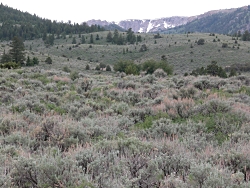
Courtesy: Intermountain Native Plant
Growers Association, www.INPGA.org
This is Linda Kervin for Bridgerland Audubon Society.
As the days lengthen and gardeners dream of the planting season to come, I urge you to consider plants adapted to our desert climate. Perhaps there are dry corners where your irrigation does not reach. Or you tire of watching the rivulets of water that run down the gutter from trying to grow grass in the strip between sidewalk and road. These are ideal areas to experiment with drought tolerant plants.
As more of us have become aware of the need to conserve water, the availability of gardening resources has increased. Many local and mail order nurseries now have a good selection of drought tolerant or xeriscape plants.

Copyright 2008 Jim Cane
The Intermountain Plant Growers Association labels nursery plants with a special tag as Utah’s Choice. Utah’s Choice plants are well adapted to the climate of the intermountain west and are a good starting point for choosing plants.
One of my favorite Utah’s Choice plants is Fire Chalice or Zauschneria latifolia. It is a spreading perennial plant that is covered in fiery red tubular flowers from midsummer til frost. Hummingbirds avidly visit this carefree, drought-tolerant plant.

Sphaeralcea ambigua
Copyright 2006-2008 Jim Cane
Maple Mallow or Illiamna rivularis is another favorite perennial. This bushy, waist-high resident of the higher mountains does well in my garden here in Logan. It is in partial sun and gets weekly watering. It is covered in large, pale pink flowers through much of the summer.
Globe mallows, genus Sphaeralcea, are another useful xeric perennial. They require bright sunshine and tolerate heavy soils. Among our natives, they are unusual for their profusion of orange-colored flowers.
These are just a few examples of the wealth of possibilities. By choosing plants adapted to your environment, you take the garden path of less resistance. When you consider the rainfall, soil and sun exposure of your yard and choose plants adapted for those conditions, you struggle less and enjoy your garden more.

Sphaeralcea ambigua
Copyright 2006-2008 Jim Cane
This is Linda Kervin for Bridgerland Audubon Society.
Credits:
Photos: Courtesy & Copyright © 2008 Intermountain Native Plant Growers Association, www.INPGA.org
Also Courtesy & Copyright © 2008 Jim Cane
Text: Linda Kervin & Jim Cane
Additional Reading:

Copyright 2008 Jim Cane
INPGA: Intermountain Native Plant Growers Association, formerly at https://www.utahschoice.org/welcome
Wildland Nursery, Joseph, UT, formerly at https://www.wildlandnursery.com/



